2019 LINCOLN CONTINENTAL warning
[x] Cancel search: warningPage 19 of 627
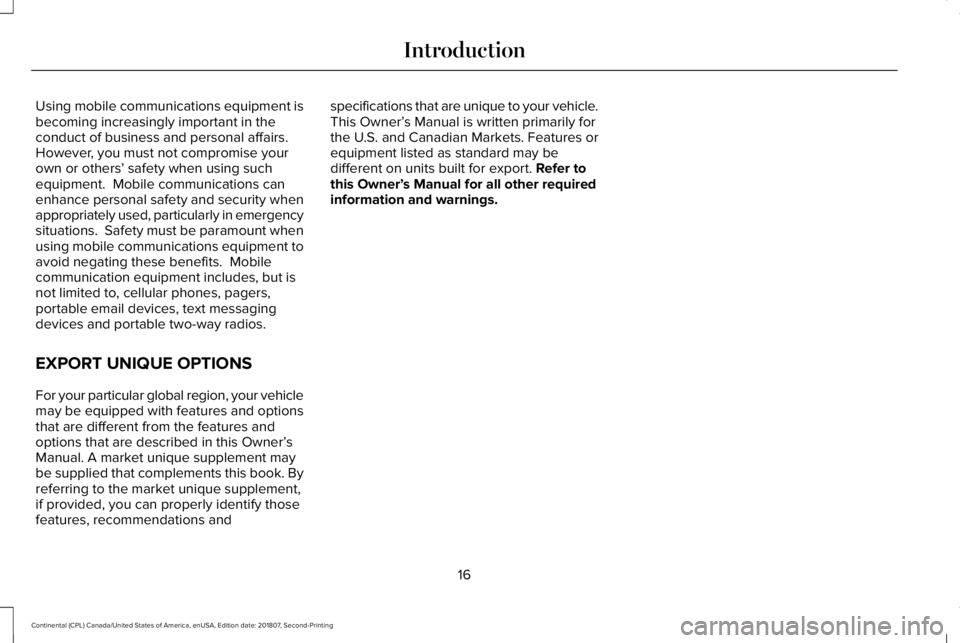
Using mobile communications equipment is
becoming increasingly important in the
conduct of business and personal affairs.
However, you must not compromise your
own or others
’ safety when using such
equipment. Mobile communications can
enhance personal safety and security when
appropriately used, particularly in emergency
situations. Safety must be paramount when
using mobile communications equipment to
avoid negating these benefits. Mobile
communication equipment includes, but is
not limited to, cellular phones, pagers,
portable email devices, text messaging
devices and portable two-way radios.
EXPORT UNIQUE OPTIONS
For your particular global region, your vehicle
may be equipped with features and options
that are different from the features and
options that are described in this Owner’ s
Manual. A market unique supplement may
be supplied that complements this book. By
referring to the market unique supplement,
if provided, you can properly identify those
features, recommendations and specifications that are unique to your vehicle.
This Owner’
s Manual is written primarily for
the U.S. and Canadian Markets. Features or
equipment listed as standard may be
different on units built for export. Refer to
this Owner’ s Manual for all other required
information and warnings.
16
Continental (CPL) Canada/United States of America, enUSA, Edition date: 201807, Second-Printing Introduction
Page 22 of 627

Direction indicators. See Direction Indicators (page 96).
A
Instrument cluster.
See Instrument Cluster (page 106).
B
Wiper lever.
See Autowipers (page 89).
C
Start button.
See Keyless Starting (page 175).
D
Hazard warning flasher switch.
See Hazard Flashers (page 277).
E
Information and entertainment display.
F
Parking aid switch.
See Parking Aids (page 215).
G
Climate controls.
See Climate Control (page 143).
H
Heated rear window switch.
See Heated Rear Window (page 147).
I
Audio unit.
J
Voice control.
See Voice Control (page 87).
K
Information display controls.
See Information Display Control (page 88).
L
Horn.M
Cruise control switches.
See Using Adaptive Cruise Control (page 234).
N
Steering wheel adjustment.
See Adjusting the Steering Wheel (page 86).
O
Audio controls.
See Audio Control (page 87).
P
Lighting control.
See Lighting Control (page 91).
Q
Parking brake.
See Electric Parking Brake (page 207).
R
19
Continental (CPL) Canada/United States of America, enUSA, Edition date: 201807, Second-Printing At a Glance
Page 23 of 627
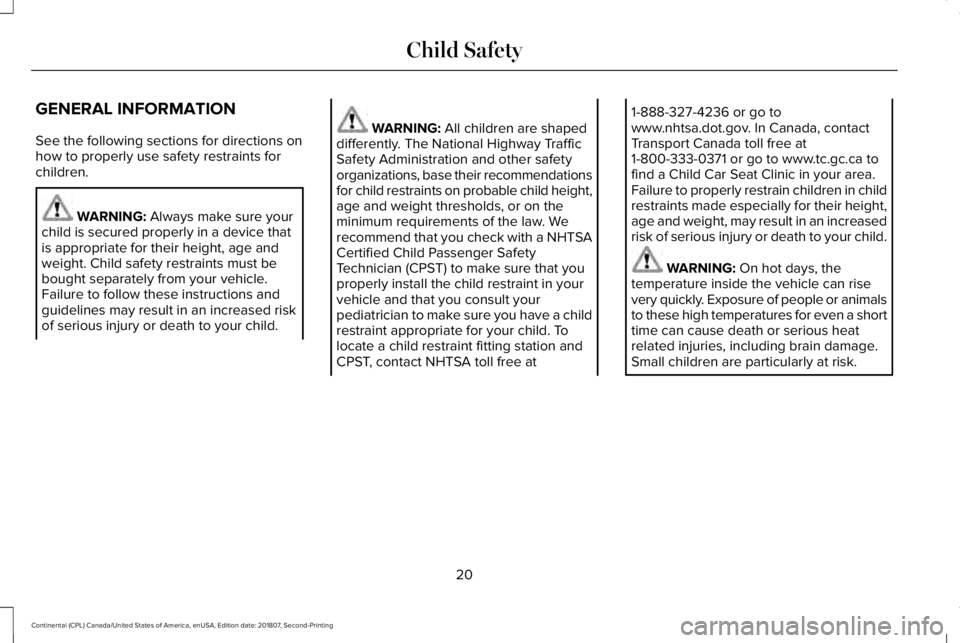
GENERAL INFORMATION
See the following sections for directions on
how to properly use safety restraints for
children.
WARNING: Always make sure your
child is secured properly in a device that
is appropriate for their height, age and
weight. Child safety restraints must be
bought separately from your vehicle.
Failure to follow these instructions and
guidelines may result in an increased risk
of serious injury or death to your child. WARNING:
All children are shaped
differently. The National Highway Traffic
Safety Administration and other safety
organizations, base their recommendations
for child restraints on probable child height,
age and weight thresholds, or on the
minimum requirements of the law. We
recommend that you check with a NHTSA
Certified Child Passenger Safety
Technician (CPST) to make sure that you
properly install the child restraint in your
vehicle and that you consult your
pediatrician to make sure you have a child
restraint appropriate for your child. To
locate a child restraint fitting station and
CPST, contact NHTSA toll free at 1-888-327-4236 or go to
www.nhtsa.dot.gov. In Canada, contact
Transport Canada toll free at
1-800-333-0371 or go to www.tc.gc.ca to
find a Child Car Seat Clinic in your area.
Failure to properly restrain children in child
restraints made especially for their height,
age and weight, may result in an increased
risk of serious injury or death to your child.
WARNING:
On hot days, the
temperature inside the vehicle can rise
very quickly. Exposure of people or animals
to these high temperatures for even a short
time can cause death or serious heat
related injuries, including brain damage.
Small children are particularly at risk.
20
Continental (CPL) Canada/United States of America, enUSA, Edition date: 201807, Second-Printing Child Safety
Page 25 of 627
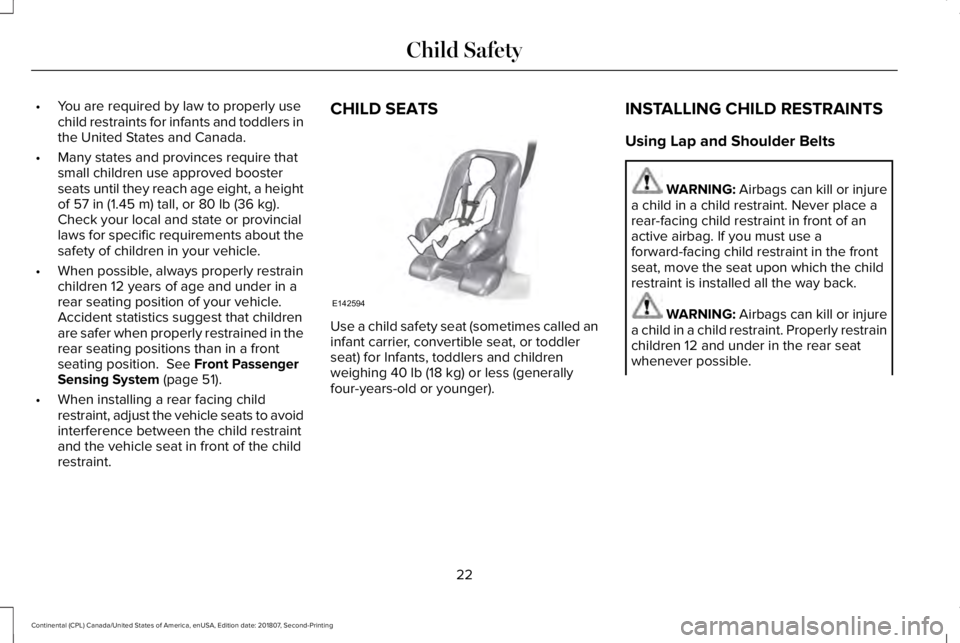
•
You are required by law to properly use
child restraints for infants and toddlers in
the United States and Canada.
• Many states and provinces require that
small children use approved booster
seats until they reach age eight, a height
of 57 in (1.45 m) tall, or 80 lb (36 kg).
Check your local and state or provincial
laws for specific requirements about the
safety of children in your vehicle.
• When possible, always properly restrain
children 12 years of age and under in a
rear seating position of your vehicle.
Accident statistics suggest that children
are safer when properly restrained in the
rear seating positions than in a front
seating position.
See Front Passenger
Sensing System (page 51).
• When installing a rear facing child
restraint, adjust the vehicle seats to avoid
interference between the child restraint
and the vehicle seat in front of the child
restraint. CHILD SEATS
Use a child safety seat (sometimes called an
infant carrier, convertible seat, or toddler
seat) for Infants, toddlers and children
weighing 40 lb (18 kg) or less (generally
four-years-old or younger). INSTALLING CHILD RESTRAINTS
Using Lap and Shoulder Belts WARNING: Airbags can kill or injure
a child in a child restraint. Never place a
rear-facing child restraint in front of an
active airbag. If you must use a
forward-facing child restraint in the front
seat, move the seat upon which the child
restraint is installed all the way back. WARNING: Airbags can kill or injure
a child in a child restraint. Properly restrain
children 12 and under in the rear seat
whenever possible.
22
Continental (CPL) Canada/United States of America, enUSA, Edition date: 201807, Second-Printing Child SafetyE142594
Page 26 of 627
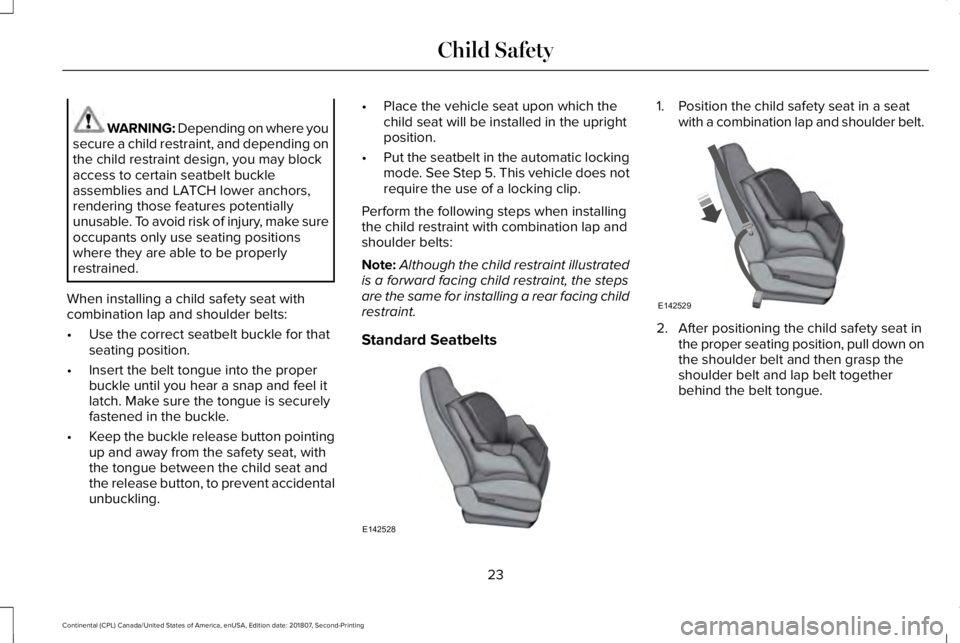
WARNING: Depending on where you
secure a child restraint, and depending on
the child restraint design, you may block
access to certain seatbelt buckle
assemblies and LATCH lower anchors,
rendering those features potentially
unusable. To avoid risk of injury, make sure
occupants only use seating positions
where they are able to be properly
restrained.
When installing a child safety seat with
combination lap and shoulder belts:
• Use the correct seatbelt buckle for that
seating position.
• Insert the belt tongue into the proper
buckle until you hear a snap and feel it
latch. Make sure the tongue is securely
fastened in the buckle.
• Keep the buckle release button pointing
up and away from the safety seat, with
the tongue between the child seat and
the release button, to prevent accidental
unbuckling. •
Place the vehicle seat upon which the
child seat will be installed in the upright
position.
• Put the seatbelt in the automatic locking
mode. See Step 5. This vehicle does not
require the use of a locking clip.
Perform the following steps when installing
the child restraint with combination lap and
shoulder belts:
Note: Although the child restraint illustrated
is a forward facing child restraint, the steps
are the same for installing a rear facing child
restraint.
Standard Seatbelts 1. Position the child safety seat in a seat
with a combination lap and shoulder belt. 2. After positioning the child safety seat in
the proper seating position, pull down on
the shoulder belt and then grasp the
shoulder belt and lap belt together
behind the belt tongue.
23
Continental (CPL) Canada/United States of America, enUSA, Edition date: 201807, Second-Printing Child SafetyE142528 E142529
Page 31 of 627

8. Remove remaining slack from the belt.
Force the seat down with extra weight,
for example, by pressing down or
kneeling on the child restraint while
pulling down on the lap belt in order to
force slack from the belt. This is
necessary to remove the remaining slack
that will exist once the extra weight of
the child is added to the child restraint.
It also helps to achieve the proper
snugness of the child restraint to your
vehicle. Sometimes, a slight lean toward
the buckle will additionally help to
remove remaining slack from the belt. 9. Attach the tether strap (if the child
restraint is equipped). 10. Before placing the child in the seat,
forcibly move the seat forward and back
to make sure the seat is securely held
in place. To check this, grab the seat at
the belt path and attempt to move it
side to side and forward and back.
There should be no more than 1 in
(2.5 cm) of movement for proper
installation. We recommend checking with a NHTSA
Certified Child Passenger Safety Technician
to make certain the child restraint is properly
installed. In Canada, check with Transport
Canada for referral to a Child Car Seat Clinic.
Using Lower Anchors and Tethers for
CHildren (LATCH)
WARNING:
Do not attach two child
safety restraints to the same anchor. In a
crash, one anchor may not be strong
enough to hold two child safety restraint
attachments and may break, causing
serious injury or death. WARNING: Depending on where you
secure a child restraint, and depending on
the child restraint design, you may block
access to certain seatbelt buckle
assemblies and LATCH lower anchors,
rendering those features potentially
unusable. To avoid risk of injury, make sure
occupants only use seating positions
where they are able to be properly
restrained.
28
Continental (CPL) Canada/United States of America, enUSA, Edition date: 201807, Second-Printing Child SafetyE146525 E142534
Page 32 of 627
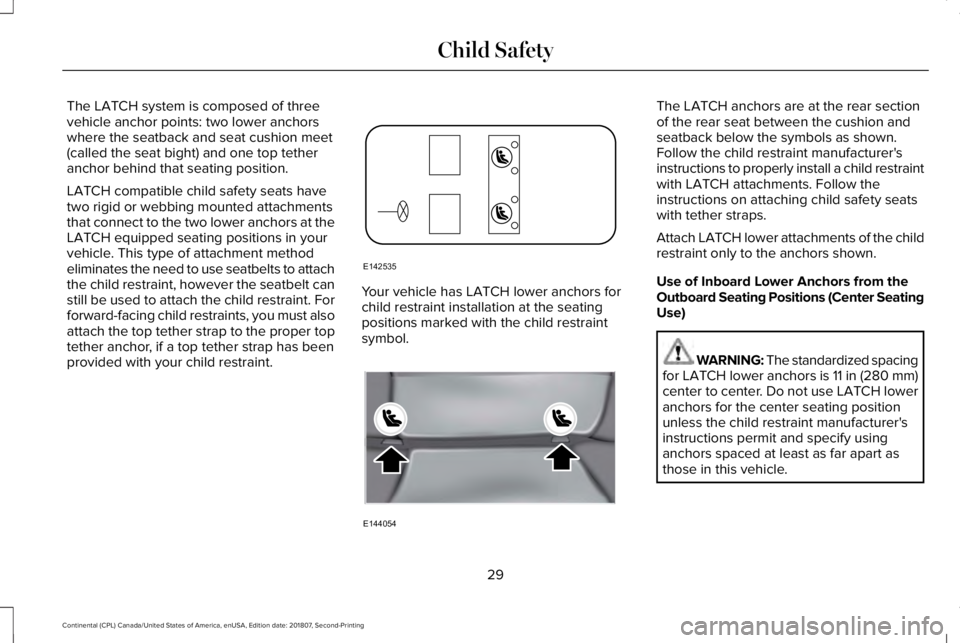
The LATCH system is composed of three
vehicle anchor points: two lower anchors
where the seatback and seat cushion meet
(called the seat bight) and one top tether
anchor behind that seating position.
LATCH compatible child safety seats have
two rigid or webbing mounted attachments
that connect to the two lower anchors at the
LATCH equipped seating positions in your
vehicle. This type of attachment method
eliminates the need to use seatbelts to attach
the child restraint, however the seatbelt can
still be used to attach the child restraint. For
forward-facing child restraints, you must also
attach the top tether strap to the proper top
tether anchor, if a top tether strap has been
provided with your child restraint.
Your vehicle has LATCH lower anchors for
child restraint installation at the seating
positions marked with the child restraint
symbol. The LATCH anchors are at the rear section
of the rear seat between the cushion and
seatback below the symbols as shown.
Follow the child restraint manufacturer's
instructions to properly install a child restraint
with LATCH attachments. Follow the
instructions on attaching child safety seats
with tether straps.
Attach LATCH lower attachments of the child
restraint only to the anchors shown.
Use of Inboard Lower Anchors from the
Outboard Seating Positions (Center Seating
Use)
WARNING: The standardized spacing
for LATCH lower anchors is 11 in (280 mm)
center to center. Do not use LATCH lower
anchors for the center seating position
unless the child restraint manufacturer's
instructions permit and specify using
anchors spaced at least as far apart as
those in this vehicle.
29
Continental (CPL) Canada/United States of America, enUSA, Edition date: 201807, Second-Printing Child SafetyE142535 E144054
Page 34 of 627
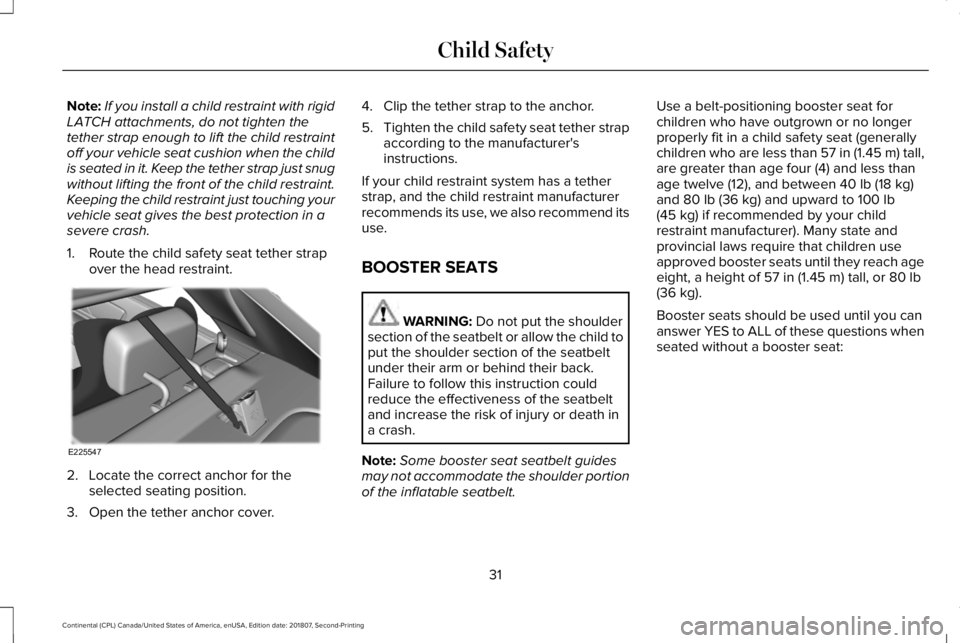
Note:
If you install a child restraint with rigid
LATCH attachments, do not tighten the
tether strap enough to lift the child restraint
off your vehicle seat cushion when the child
is seated in it. Keep the tether strap just snug
without lifting the front of the child restraint.
Keeping the child restraint just touching your
vehicle seat gives the best protection in a
severe crash.
1. Route the child safety seat tether strap over the head restraint. 2. Locate the correct anchor for the
selected seating position.
3. Open the tether anchor cover. 4. Clip the tether strap to the anchor.
5.
Tighten the child safety seat tether strap
according to the manufacturer's
instructions.
If your child restraint system has a tether
strap, and the child restraint manufacturer
recommends its use, we also recommend its
use.
BOOSTER SEATS WARNING: Do not put the shoulder
section of the seatbelt or allow the child to
put the shoulder section of the seatbelt
under their arm or behind their back.
Failure to follow this instruction could
reduce the effectiveness of the seatbelt
and increase the risk of injury or death in
a crash.
Note: Some booster seat seatbelt guides
may not accommodate the shoulder portion
of the inflatable seatbelt. Use a belt-positioning booster seat for
children who have outgrown or no longer
properly fit in a child safety seat (generally
children who are less than 57 in (1.45 m) tall,
are greater than age four (4) and less than
age twelve (12), and between
40 lb (18 kg)
and 80 lb (36 kg) and upward to 100 lb
(45 kg) if recommended by your child
restraint manufacturer). Many state and
provincial laws require that children use
approved booster seats until they reach age
eight, a height of
57 in (1.45 m) tall, or 80 lb
(36 kg).
Booster seats should be used until you can
answer YES to ALL of these questions when
seated without a booster seat:
31
Continental (CPL) Canada/United States of America, enUSA, Edition date: 201807, Second-Printing Child SafetyE225547